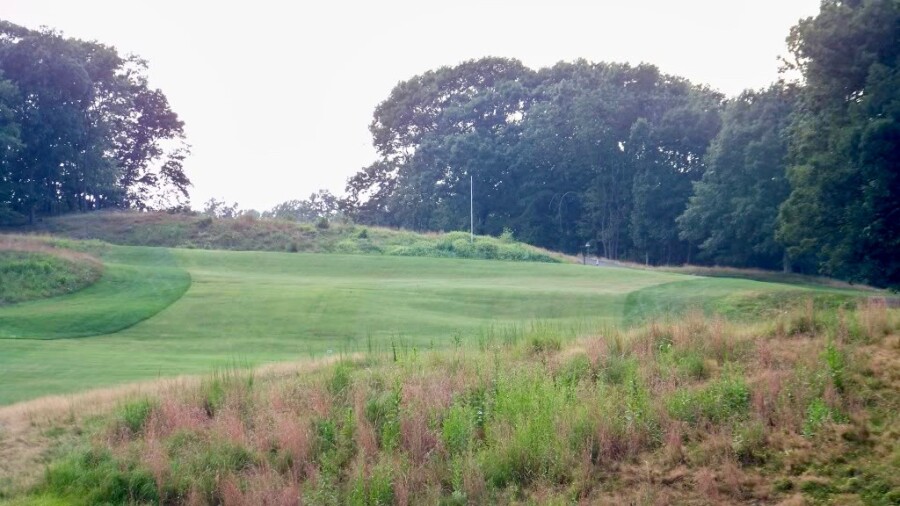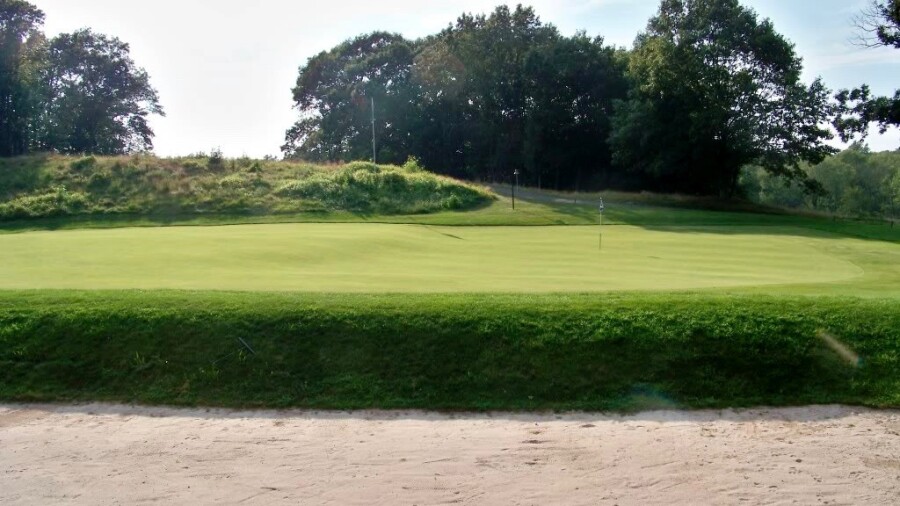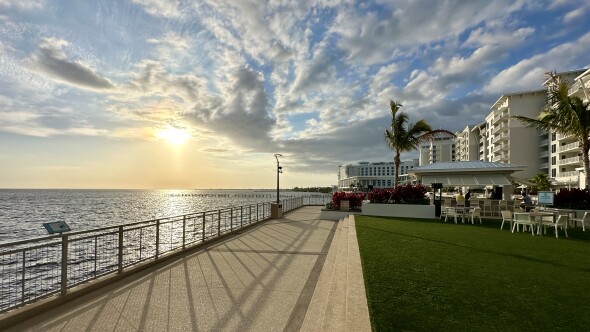Whether they'll admit it or not, people generally like rules. They tend to try and fit things neatly into a pre-defined set of parameters in order to make sense of them, whether or not those parameters are ultimately appropriate. Straying from those artificially-imposed boundaries is a good way to be labeled an outlaw, heretic or iconoclast.
But rule-breakers are the ones who spark progress, especially in the arts, where certain long-held tenets are often the most bewilderingly arbitrary.
Golf course architecture is an art form, but especially as it has become big business and a lucrative profession, many rules have sprung up that tend to constrain developers and architects, hampering efforts to built the most compelling possible collection of holes and, therefore, the most compelling possible course.
These holes and courses break the rules, and the world is all the more fortunate as a result.
Rule 1: The first hole should always be a “gentle handshake” that eases players into the round

This design “rule” might be my biggest pet peeve. Architects only have a set number of chances – 9 or 18 (more on this later) – to surprise and delight golfers. Why discard one of them just to appease golfers who feel entitled not to be challenged at the start of the round?
Some of the courses I’m fondest of have memorable first holes. The Old White TPC at The Greenbrier starts off with a strong par 4 that requires two confident full swings. On the flip side, the Country Club of Farmington in Connecticut starts with a quirky 285-yard two-shotter that can be driven, but not without considerable risk, as out-of-bounds bumps up against the side of the green and the land slopes away steeply long and left.
Rule 2: The 18th hole should never be a par 3

What’s wrong with the opportunity to finish a round off with a hole-in-one? Another advantage is that a playoff in a match or tournament can be conducted more quickly on a par 3 than a four or five.
Call The Old White TPC a two-time rule-breaker because its own finisher is a splendid short par three with a green that houses some tricky pin positions. Not far away, the delightful Cascades Course at The Homestead also ends on a par 3, albeit one that measures more than 200 yards from the tips. The PGA Tour recently kowtowed to this arbitrary rule, reversing the nines at East Lake Golf Club for the Tour Championship and doing away with its own par-3 finisher.
Rule 3: The 18th hole should be challenging, in order to settle bets

Long, difficult 18th holes are a big-time golf cliché. I love Pete Dye’s golf courses, and I’m a Tom Fazio fan, too, but both men’s portfolios are chock-a-block with long par-4 18th holes. I think there are other ways to cap off a great golf course.
One relatively gentle finisher is at The Old Course. Sure, the Valley of sin is tricky, but any successful tee shot up the massive fairway leaves a short iron into the green. Finishing with a birdie just heightens the desire to go right back to the first tee and play again.
Rule 4: The 18th hole should be a climax point in the round
The Old Course's 18th is pretty mundane if you hold the amazing setting aside (a big "if," I know). Not every great piece of music finishes with a cymbal crash, and not every golf course needs to go out with a bang, either.
At the vaunted Cypress Point Club, the 18th is a quiet finish: a shortish par 4 back to the clubhouse after one of the most exciting and gorgeous seaside stretches of golf in creation. Only true curmudgeons would hold the finisher against a course with some of the highest highs in the game.
Rule 5: The 18th hole should never point west

Proper routing is an essential trait of great golf courses, and one of the accepted tenets of routing is to avoid a finishing hole that faces the setting sun if at all possible.
Luckily, the 18th at Pebble Beach Golf Links was not built with this rule in mind. Otherwise, we might have been robbed of one of the game’s great endings. A kindred spirit: The Country Club in Brookline, Massachusetts, where not only does the 18th head into the setting sun, the first hole heads due east, into the rising sun!
Rule 6: Golf courses should have nine or 18 holes

I will admit that I don’t mind this rule so much. Regulation pro baseball games comprise nine innings and a game of bowling is 10 frames, which is fine. But after playing the 13-hole Mountain Top Course at Big Cedar Lodge recently, and touring the 17-hole Sandbox Course at Sand Valley Golf Resort last summer, I’m less fanatical about golf's particular standard, although I do think the test of holding oneself together for 18 holes is a legitimate one. If I play the 12-hole Shiskine Golf Club in Scotland sometime, I hope I’ll have time to go around at least twice.
Rule 7: Blind shots should be avoided
There aren’t very many truly blind shots in golf – often there’s some subtle or overt indicator of the way to go. And besides, shots are only blind the first time around. A good memory is a 15th club in these situations.
Blind shots on the world’s great links are legion, but some of my favorites come stateside, at The Course At Yale. On the par-4 third and 12th holes, a flagpole is the only frame of reference for the green’s location as seen from the landing area. Committing to hitting a shot at an unseen target is a real golf skill that bulldozers have kept from being tested more often. It’s a shame.
Rule 8: "Championship" courses should have two par 3s, five par 4s and two par 5s on each nine
This is another of the finer points of routing. Why impose some artificial standard on a piece of land when that would mean sacrificing the quality of the course? The Island Golf Club in Ireland begins with eight straight par 4s, then a par 3.
Rule 9: Runs of consecutive par 3s or par 5s are weird or bad

Once again, I would want the architect of my golf course to allow it to unfold in a sequence that harmonizes with the land. Here are a few quirky routings that flout this rule:
- Lawsonia Links, one of my all-time favorites, goes 5-3-5-3-5-3 from the ninth through 14th holes.
- Manchester Country Club, an underrated central Connecticut muni, has two pairs of consecutive par 5s.
- Cabo Del Sol’s Ocean Course, one of Jack Nicklaus’ best, has consecutive par 3s at the sixth and seventh.
- Inwood Country Club on Long Island, has three straight par fives, followed by two consecutive par threes at holes three through seven.
- One course I’m intrigued to play sometime is Lake Geneva Country Club in Wisconsin. It has three(!) straight par 3s at the ninth through 11th.
Rule 10: Short holes relative to par should have small greens to defend themselves from birdies

This bogus “rule” stems from a notion that green contours themselves aren’t a sufficient defense for a particular hole. Two examples of Tom Doak’s work break this rule brilliantly. The short par-3 fifth at Bandon Dunes’ Old Macdonald plays to one of the course’s largest greens. So, too, does the short par-4 sixth at his Streamsong Blue in Florida.
Rule 11: Long par 4s should have big greens so as not to be overly difficult
This rule inverts the previous one. If you think a long par four with a small green is inherently “unfair,” you could probably do with some remedial long-iron practice. Such holes become as much mental as physical tests, daring the golfer to let frustration or a misplaced sense of injustice threaten to turn a par into a double bogey. The long par-4 15th at the Kingsley Club in northern Michigan, a Mike DeVries masterpiece, has the smallest green on the entire course. How rewarding it must feel to make a par!
That's right: even though the title says mentions 10 rules, I gave you 11. Deal with it.














should trees be planted in rows (2,3,4 rows)- on sides of fairways, making it very hard to get out from behind with out going backwards or sideways to get on the fairway
I believe that the player is entitled to see the flagstick on his shot to the green. Robert T. ("Bobby") Jones firmly believed in this principle. This rule should be "violated" only if the architect can't "work" his way around the problem. Blind tee shots are very acceptable.
If possible, the first hole should be long and wide open. Why? To get play moving and not have a backup on the 1st tee.
Hi, there was a course In Broward Co. Florida that had 6-3, 6-4 and 6 par 5 . It was really fun to play and with island greens too. Unfortunately it was closed some years back. I miss it.
Balance the course:
6 par 3's
6 par 4's
6 par 5's
1st hole. Par4 then in succession
Par 3 then
Par 5
You end 9 holes and 18 with a par 5
I have played Shiskine Golf Club, 3 rounds over 3 days. Magnificent! Time to play 1hr 50m, 2hrs and 2hrs 10m. Worth the trip.
Highlands County Club in Highlands N.C. designed by Donald Ross and christened by Bobby Jones who hit the first shot when the course was opened ends with a great par three. The course has an unusual par 3, par 5, par 3 finished. Our club pro was once playing there and finished 2, 3, 1 five under par on the last three holes!
Sadly One of the quirky courses of all time was Glen Garden Golf & Country Club. The back nine 2 par 4's, then 2 par 5's followed by 2 par 3's,
a par 4 finishing with 2 par 3's. It is gone now in the hands of a Whiskey Distillery. After all their construction which they had to convert another 3 holes to par 3's. They vow to maintain the course, but not to the public.
You teed off on number one wanting to test yourself against a golf course. Play it and enjoy what it takes to play it. Who cares if it has 3 straight par 3's.
I play on courses generally known only by the locals. Those advocating 6's, I used to play Westridge in McKinney, TX which has three 3's, 4's and 5's per side and no two holes repeat par except 9 and 10. I actually like the opportunity to play short irons off the tee where driving for dough also has to be precise and the ability to open up more than a couple times on the 5's. Blind holes? Fox Hollow Canyon Course #5 in Lakewood, CO. Green nowhere in site, 200 yd. layup to an approach for the green 80 ft. over a wildlife protected ravine. Links #8, P-3, blind over a knoll, over a lake to a green you can only see from the side of the tee boxes. Pretty cool holes.
In the old days, at Glendale Golf & Country Club, in Hamilton Ontario, they had 3 Par 3;s in a row and 4 Par 3's in 5 holes, on the front 9. It went 5,4,3,4,3,3,3,4,5. 34. The back nine was long 5,4,4,5,5,3,4,4,4 38 Par 72. The scenery around the course is incredible.